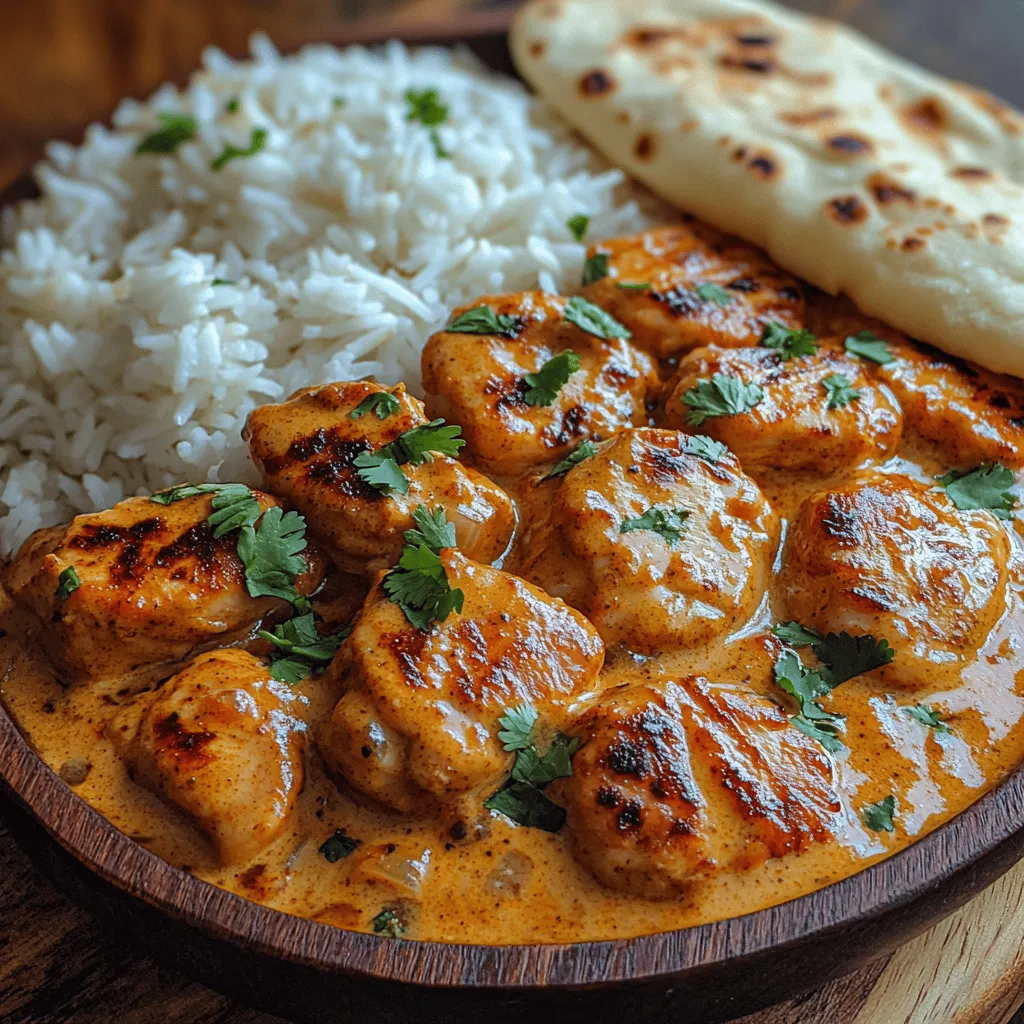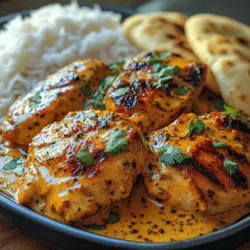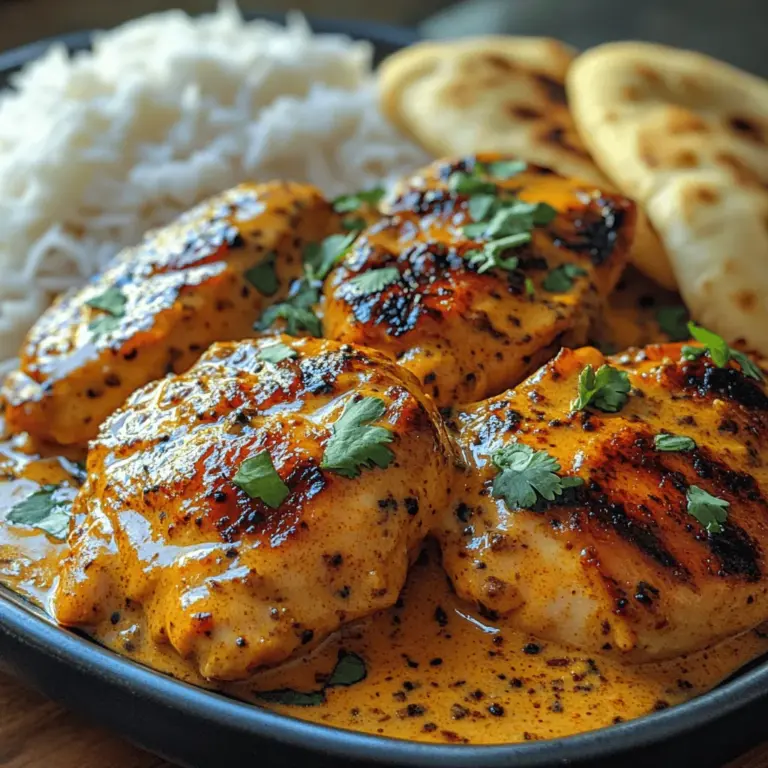Introduction
Butter chicken, also known as Murgh Makhani, is a culinary treasure hailing from the vibrant tapestry of Indian cuisine. This dish has woven itself into the hearts and homes of food enthusiasts around the globe, captivating taste buds with its rich, creamy texture and aromatic spices. The origins of butter chicken trace back to the 1950s in Delhi, where it was created by the chefs of the Moti Mahal restaurant. This innovative dish was born out of a desire to utilize leftover tandoori chicken, transforming it into a luscious, buttery tomato sauce that has since become a staple in Indian restaurants worldwide.
The Butter Chicken Bliss recipe not only promises a delectable taste but also showcases the artistry involved in marrying spices and cream to create an indulgent experience. With tender chicken marinated in yogurt and a blend of aromatic spices, all simmered in a rich tomato-cream sauce, this dish is perfect for family dinners or special occasions. Its appeal lies not only in its flavor but also in its cultural significance, as it represents a fusion of rich culinary traditions that have evolved over time. In this article, we will delve into the key ingredients, cooking techniques, and the cultural background of butter chicken, ensuring you can recreate this restaurant-quality dish in the comfort of your own kitchen.
Understanding the Ingredients
To craft the perfect Butter Chicken Bliss, it’s essential to understand the role each ingredient plays in the overall flavor and texture of the dish. Here’s a closer look at the foundational elements that make this recipe stand out.
Chicken
The choice of chicken is crucial to achieving the desired juiciness and flavor. For this recipe, boneless chicken thighs are recommended. Unlike chicken breasts, thighs are more forgiving when cooked and retain moisture better, resulting in a tender and juicy final product. The dark meat also has a richer flavor that pairs beautifully with the creamy sauce.
Yogurt
Yogurt is a key ingredient in the marination process, serving as both a tenderizer and a flavor enhancer. The acidity in yogurt breaks down the proteins in the chicken, ensuring that it becomes succulent and flavorful. Moreover, the tangy notes imparted by the yogurt create a delightful contrast against the richness of the sauce.
Spices
The signature flavor profile of Butter Chicken Bliss comes from a carefully curated blend of spices. The combination of garam masala, curry powder, turmeric, and cumin not only adds depth but also provides an aromatic complexity that is characteristic of Indian cuisine. Garam masala, a spice blend that varies by region, typically includes cinnamon, cardamom, and cloves, all of which contribute to the warm, inviting fragrance of the dish.
Vegetable Oil
For sautéing the chicken and aromatics, vegetable oil is preferred due to its high smoke point. This allows for high cooking temperatures without burning, which is essential for achieving the perfect sear on the chicken and developing the flavors in the sauce.
Aromatics
Onions, garlic, and ginger form the aromatic base of the sauce, infusing it with depth and fragrance. Sautéing these ingredients until they are golden and fragrant is a critical step in building the dish’s flavor profile. The natural sweetness of caramelized onions balances the acidity of the tomatoes, creating a well-rounded sauce.
Tomatoes and Cream
Crushed tomatoes are a vital component of the sauce, providing acidity and a rich, tangy flavor. The tomatoes create a luscious base that is further enriched by the addition of heavy cream, which contributes to the dish’s luxurious texture and helps mellow out the spices. The cream also gives the sauce its characteristic silky smoothness, making every bite an indulgent experience.
Garnish
To elevate the presentation and add a fresh element to the dish, fresh cilantro is used as a garnish. Not only does it provide a pop of color, but it also adds a burst of freshness that complements the richness of the butter chicken.
Marinating the Chicken
Importance of Marination
Marinating the chicken is a crucial step in the Butter Chicken Bliss recipe, as it enhances both flavor and tenderness. The process of marination allows the spices and yogurt to penetrate the chicken, resulting in a more flavorful and juicy final dish. This step is not merely a formality; it is an essential technique that transforms ordinary chicken into a culinary masterpiece.
Marination Process
To begin the marination process, follow these steps:
1. Prepare the Marinade: In a large bowl, combine plain yogurt with various spices, including garam masala, curry powder, turmeric, cumin, and salt. Feel free to adjust the spice quantities based on your personal preference for heat and flavor intensity.
2. Add the Chicken: Cut the boneless chicken thighs into bite-sized pieces, ensuring even cooking. Add the chicken to the marinade, mixing well to coat each piece thoroughly.
3. Seal and Refrigerate: Cover the bowl with plastic wrap or transfer the mixture to a zip-top bag, removing as much air as possible. Allow the chicken to marinate in the refrigerator for at least 30 minutes. For optimal results, aim for 2 to 4 hours of marination, allowing the flavors to meld and intensify.
Timing
The duration of marination can significantly impact the final dish. A quick 30-minute marination will impart some flavor, while a longer marination of 2 hours or even overnight will yield chicken that is bursting with flavor and incredibly tender. If you have the time, consider marinating overnight to achieve the best results.
Cooking the Chicken
Once the chicken is properly marinated, it’s time to cook it to perfection.
Browning Techniques
To achieve a beautifully golden-brown exterior, it’s essential to cook the chicken in batches. This prevents overcrowding in the pan, which can lead to steaming rather than browning. In a large skillet or heavy-bottomed pan, heat a few tablespoons of vegetable oil over medium-high heat.
1. Sear the Chicken: Add a portion of the marinated chicken to the hot oil, ensuring that the pieces are not touching each other. Let them sear without moving them for about 3-4 minutes until they develop a golden-brown crust.
2. Flip and Cook: Flip the chicken pieces and cook for an additional 2-3 minutes until browned and cooked through. Use a meat thermometer to ensure that the internal temperature reaches 165°F (75°C).
3. Remove and Repeat: Remove the cooked chicken from the pan and set it aside. Repeat the process with the remaining chicken, adding more oil if necessary. This step is crucial for flavor development, as the browned bits left in the pan will enhance the sauce.
Flavor Development
Browning the chicken not only enhances its flavor but also contributes to the overall taste of the Butter Chicken Bliss. The caramelization process creates a depth of flavor that cannot be achieved through boiling or steaming. As the chicken cooks, the fond (the brown bits that stick to the bottom of the pan) will add complexity to the sauce, making every bite a delightful experience.
Sautéing Aromatics
With the chicken cooked to perfection and set aside, it’s time to build the sauce by sautéing the aromatics.
1. Sauté the Onions: In the same pan used for the chicken, reduce the heat to medium and add a bit more oil if needed. Add chopped onions and sauté until they become translucent and begin to caramelize, about 5-7 minutes. This step is essential for developing the sweetness and depth of flavor in the sauce.
2. Add Garlic and Ginger: Once the onions are well-cooked, add minced garlic and grated ginger. Sauté for an additional 1-2 minutes, stirring frequently to prevent burning. The combination of these aromatics will fill your kitchen with an irresistible fragrance.
3. Creating the Sauce Base: After the garlic and ginger are fragrant, it’s time to add the crushed tomatoes. Stir well to combine, scraping up any browned bits from the bottom of the pan to infuse the sauce with flavor. Allow the mixture to simmer for about 10 minutes, letting the flavors meld and the sauce thicken.
As we continue to develop this Butter Chicken Bliss recipe, we will explore the next steps in creating this iconic dish, ensuring you have all the tools and insights needed for a successful culinary journey.

Building Flavor
Creating the perfect Butter Chicken starts with building a fragrant base. Sautéing onions, garlic, and ginger is essential in developing the depth of flavor that makes this dish so irresistible. Begin by heating a generous amount of ghee or oil in a heavy-bottomed pan over medium heat. Add finely chopped onions and sauté them until they turn golden brown. This caramelization process not only enhances the natural sweetness of the onions but also adds a rich depth to the dish.
Once the onions are translucent and slightly browned, incorporate minced garlic and ginger. Both ingredients bring essential aromatic qualities to your butter chicken, infusing the oil and onions with their unique flavors. Sauté these aromatics for about 2-3 minutes, stirring frequently to prevent burning. You’ll notice a delightful fragrance filling your kitchen, setting the stage for the rest of the cooking process.
Cooking Techniques
To achieve the ideal texture and aroma from your aromatics, it’s crucial to maintain the right heat. Cooking on medium heat allows the onions to caramelize evenly without burning, while the garlic and ginger can mellow out their raw sharpness. If you find that your mixture is browning too quickly, reduce the heat slightly. Remember, patience is key here; allowing the aromatics to develop fully will significantly enhance the overall flavor profile of your butter chicken.
Crafting the Sauce
Combining Ingredients
With your base ready, it’s time to craft the sauce. Begin by adding crushed tomatoes to the pan. You can use canned tomatoes for convenience, but fresh tomatoes will impart a brighter flavor. Stir the mixture well to combine with the sautéed onions, garlic, and ginger. Allow this to cook for about 5-7 minutes until the tomatoes break down and meld into a thick sauce.
Next, it’s time to introduce the cream. This is what gives butter chicken its signature richness. Pour in heavy cream, stirring it into the tomato mixture until you achieve a smooth, velvety consistency. The cream balances the acidity of the tomatoes and adds a luxurious mouthfeel, making your sauce irresistible.
Simmering for Flavor
Simmering is a crucial step in developing the flavors of your butter chicken. Once the cream is fully incorporated, reduce the heat to low and let the sauce simmer for 15-20 minutes. This gentle heat allows all the flavors to meld together beautifully, creating a cohesive sauce. Keep the pan partially covered to prevent splatters while still allowing some steam to escape. Stir occasionally to ensure nothing sticks to the bottom of the pan.
Bringing It All Together
Combining Chicken and Sauce
After the sauce has simmered to perfection, it’s time to incorporate the marinated chicken. Add the chicken pieces to the pan, ensuring they are well-coated with the sauce. Stir gently to combine everything thoroughly. The chicken should be submerged in the sauce, allowing it to absorb all those delightful flavors.
Final Simmer
Allow the dish to simmer for an additional 15-20 minutes on low heat, or until the chicken is cooked through and tender. This final simmer is essential; it not only ensures the chicken is fully cooked but also allows the flavors to deepen further. If the sauce seems too thick during this process, you can add a splash of water or additional cream to reach your desired consistency.
Serving Suggestions
Accompaniments
Butter chicken shines when served with fluffy basmati rice or warm naan. The rice acts as a perfect vehicle for soaking up the rich sauce, while naan provides a delightful way to scoop up the tender chicken. For a complete meal, consider serving a side of sautéed vegetables or a fresh cucumber salad to add a refreshing contrast to the creamy sauce.
Garnishing
Presentation is key, and garnishing your butter chicken elevates its appeal. Just before serving, sprinkle freshly chopped cilantro over the dish. Not only does this add a pop of color, but it also contributes a burst of fresh flavor that balances the richness of the sauce. For an extra touch, you can also add a swirl of cream on top for visual appeal.
Nutritional Information
Caloric Breakdown
Butter chicken, while indulgent, can still be a part of a balanced diet. A typical serving (about 1 cup) contains approximately 450-500 calories, depending on the amount of cream used and the serving size of chicken. The dish is rich in protein from the chicken and provides a good source of fat from the cream and butter, which are essential for satiety.
Balanced Meal Considerations
To ensure that your butter chicken aligns with a balanced meal, pair it with whole grains like brown rice or quinoa, which can offer added fiber. Including a fresh salad or steamed vegetables will enhance the nutritional profile of your meal, providing necessary vitamins and minerals. This approach not only makes for a hearty dish but also allows you to enjoy the flavors of butter chicken guilt-free.
The Cultural Significance of Butter Chicken
Historical Context
Originating in the 1940s at the Moti Mahal restaurant in Delhi, butter chicken was created by chance when leftover chicken was cooked with tomatoes, butter, and cream. This innovative dish quickly became a staple in Indian cuisine, beloved for its creamy texture and rich flavors. Its humble beginnings highlight the creativity of Indian cooks who transformed simple ingredients into a culinary masterpiece that has stood the test of time.
Global Influence
Over the years, butter chicken has transcended cultural boundaries, becoming a favorite in households around the world. Its unique blend of spices and creamy sauce appeals to a wide audience, leading to its inclusion in menus globally. Today, you can find butter chicken in Indian restaurants from New Delhi to New York, and its popularity continues to grow, making it a beloved dish in various forms and adaptations.
Conclusion
Butter Chicken Bliss is more than just a meal; it’s an experience that brings warmth and joy to any dining occasion. By understanding the ingredients, mastering the cooking techniques, and appreciating its cultural significance, you can recreate this classic dish with confidence and pride. Whether enjoyed as a comforting weeknight dinner or served at a festive gathering, this butter chicken recipe is sure to impress and satisfy all who partake. Dive into the world of flavors and aromas that butter chicken offers, and let it transport you to the heart of Indian culinary tradition.


